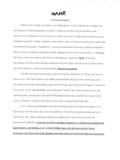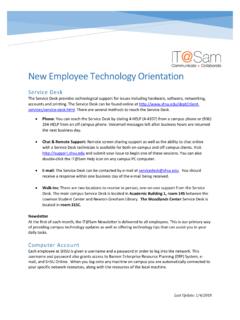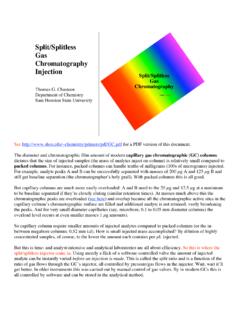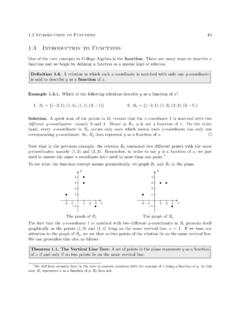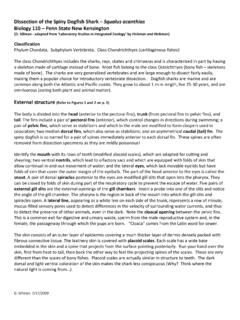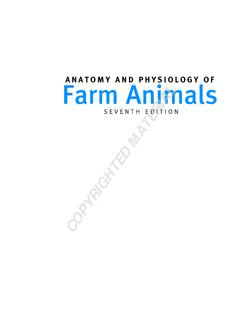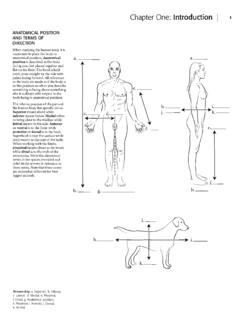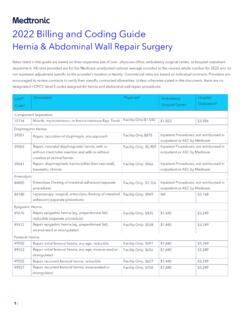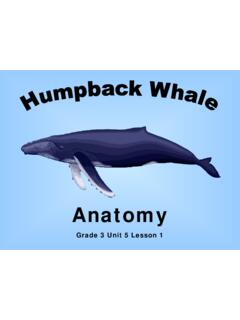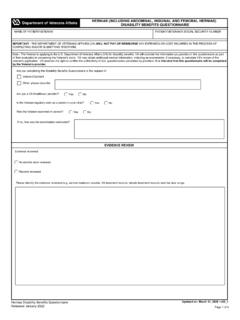Transcription of Fetal Pig Dissection Lab - Sam Houston State University
1 1 Fetal Pig Dissection Labs Dr. J. Lim Objective: In this exercise you will examine the organization of the many body systems studied this semester in the context of a single specimen, the Fetal pig. Be sure to identify the major organs as you explore the extent of each system. As you encounter each structure, discuss its function and interactions with surrounding structures with your lab partners Recommendations: Carefully follow the directions Read the description of each incision and understand it prior to beginning Each group should have a directions reader and a dissector The rest of the group should follow along referring to the textbook or lecture notes with details on the structures being studied Use the scissors for most incisions All students handling the specimen must wear gloves Use the scalpel only when absolutely necessary Clean-up at the end of each Dissection .
2 Dispose of lab discards in the provided receptacles Place your pig into the plastic bag provided o Expel excess air from the bag and tie it shut o Write your group name and class time on the tag provided and attach it to the bag o Place the bags in the storage bin for your class Return Dissection instruments to their proper places in the set-up tray Clean table tops with red bottled sanitizer Wash hands before leaving class 2 Fetal PIG LAB ONE: Respiratory 1, Mouth, Pharynx & Thorax External Anatomy Examine the Fetal pig and locate the external features shown above. Two rows of nipples of mammary glands are present on the ventral abdominal surface of both males and females. Mammary glands later develop only in maturing females. Umbilical cord: Make a transverse cut through the umbilical cord and examine the cut end.
3 Locate the two umbilical arteries that carry blood from the Fetal pig to the placenta, and the single umbilical vein that delivers nutrient-rich blood back to the Fetal pig. Determine the sex of your specimen o Female: The urogenital opening in the female is immediately ventral to the anus and has a small genital papilla marking its location. o Male: The scrotal sac is ventral to the anus and a urogenital opening is just posterior to the umbilical cord. Positioning the pig for Dissection Place the Fetal pig on a dissecting tray ventral (belly) side up. Use two or three rubber bands to tie the right hind leg around the ankle. Run the rubber bands around the underside of the tray and tie the left hind leg. Repeat for the forelegs. 3 Dissection Procedure HEAD AND NECK To expose the structures of the mouth and pharynx, start by inserting a pair of scissors in the angle of the lips on one side of the head and cut posteriorly through the cheek.
4 Open the mouth as you make your cut and follow the curvature of the tongue to avoid cutting the roof of the mouth. Hold down the epiglottis and surrounding tissue and continue your incision dorsal to it and on into the opening of the esophagus. Now, repeat the procedure on the other side so that the lower jaw can be pulled down to expose the structures of the mouth and pharynx as shown. Teeth: Only a few deciduous canine and/or incisor teeth will have erupted. Other teeth are still being formed and may present as bulges of the gums. Make an incision in one of these bulges to observe the developing tooth. Tongue: The tongue is attached posteriorly and free anteriorly. Locate the papillae on its surface, especially near the base of the tongue and along its anterior margins.
5 You will recall that papillae are the home of many microscopic taste buds. Hard & Soft palate: roof of the mouth o formed anteriorly by the hard palate supported by bone and cartilage o formed posteriorly by soft palate o paired nasal cavities lie dorsal to the roof of the mouth Nasopharnyx: space posterior to the nasal cavities and soft palate o contiguous with the oropharynx or throat Oropharynx (throat): space posterior to the mouth o Posterior extension of nasopharynx o may be difficult to visualize because incision cuts through it on each side. 4 When you have completed your observations, close the lower jaw by wrapping a single rubber band around the snout. GENERAL INTERNAL ANATOMY Using a sharp scalpel, make a small incision through the abdominal skin and muscle about -inch above the umbilical cord.
6 IMPORTANT: Do not use the scalpel for further Dissection work today. Use scissors to continue cutting along the midsagittal line on the ventral surface (INCISION 1), first cutting upward toward the neck (it will be necessary to cut through the ribs as well). Be careful not to cut any underlying organs Always cut away from yourself when using scissors for better control Rotate the dissecting pan as necessary for better access Turn the tray around and cut down to the caudal (tail) end of the pelvic region, leaving - inch border around the umbilical cord. This step is important to prevent cutting of the umbilical vein and arteries in the abdominal cavity. Continue the midsagittal cut down into the pelvic region. Cut around the other side of the umbilical cord (INCISION 2), again leaving about a -inch border.
7 Stop your cut about one inch short of the anus. Make the two lateral incisions just in front of the hind legs (INCISION 3). If you have a male pig, cutting off-center ensures that you do not cut the penis, which is incompletely formed in the Fetal pig and appears as a thickened tube within the skin of the lower abdominopelvic area. You may omit INCISION 4. Make two lateral incisions (INCISION 5) through muscle and ribs out from the midline incision. Lifting the lateral flaps of ribs, skin and muscle on each side, cut the diaphragm, which is attached to the inside body wall. You should now be able to peel open the left and right flaps of the ventral body wall like a book. Wash out the cavities of the pig in a sink if needed to remove any brownish material (mainly bile and clotted blood) while being careful to keep the organs in place.
8 You may loop the rubber bands around the legs as necessary to get a better view into your specimen. When you are finished with your pig, do not cut the rubber bands! Simply slide the rubber band from under the pan so that next time you need not retie the pig. 5 THORACIC ORGANS Lungs: The thoracic cavity is divided into left and right pleural cavities containing the lungs. At the midline, the inner thoracic wall forms a partition between the pleural cavities called the mediastinum. Heart: The heart can be found enclosed in the pericardial sac located within the mediastinum and attached to the diaphragm. Remove this sac to expose the heart. Fetal PIG LAB TWO: Respiratory 2, Neck & Cardiovascular NECK In the neck region, locate the larynx (voice box) which is composed of cartilage and contains the vocal cords.
9 The trachea (windpipe) extends posteriorly from the larynx and splits dorsal to the heart to form the bronchi that enter the lungs. These structures are more clearly visible after the heart has been removed. Thymus gland: whitish gland that lies near the anterior margin of the heart and extends into the neck on each side of the trachea Thyroid gland: on anterior surface of the trachea at the base of the neck Remove the thymus and thyroid glands as necessary to get a better view of the trachea and larynx, but do not cut major blood vessels Esophagus: carefully remove the connective tissue supporting the trachea so that you can move the trachea to one side to expose the esophagus located dorsal to it o you will get a better view of the esophagus later on 6 CARDIOVASCULAR SYSTEM Study the heart, major veins, and major arteries by carefully removing tissue as necessary to expose the vessels.
10 This is best done by separating tissues with a blunt probe and by picking away connective tissue (CT) from the blood vessels with a forceps. In a fetus, the placenta is the source of oxygen and nutrients, and also removes metabolic wastes from the blood. The lungs, digestive tract, and kidneys are nonfunctional. Circulatory adaptations to this condition make the circulation of blood in the fetus quite different from your study of the adult cardiovascular system. Identify the following structures using the illustration as reference: Heart: carefully cut away the pericardial sac from heart and great vessels o locate atria, ventricles, coronary vessels Anterior vena cava: returns blood from head, neck, and forelegs to right atrium Posterior vena cava: returns blood from regions posterior to heart to right atrium Pulmonary artery (trunk): carries blood from right ventricle Aorta: carries blood from left ventricle Umbilical vein: carries blood rich in oxygen and nutrients from placenta to fetus Ductus venosus: segment of umbilical vein going to liver and on to posterior vena cava carrying blood rich in placental oxygen and nutrients 7 Ductus arteriosus.
